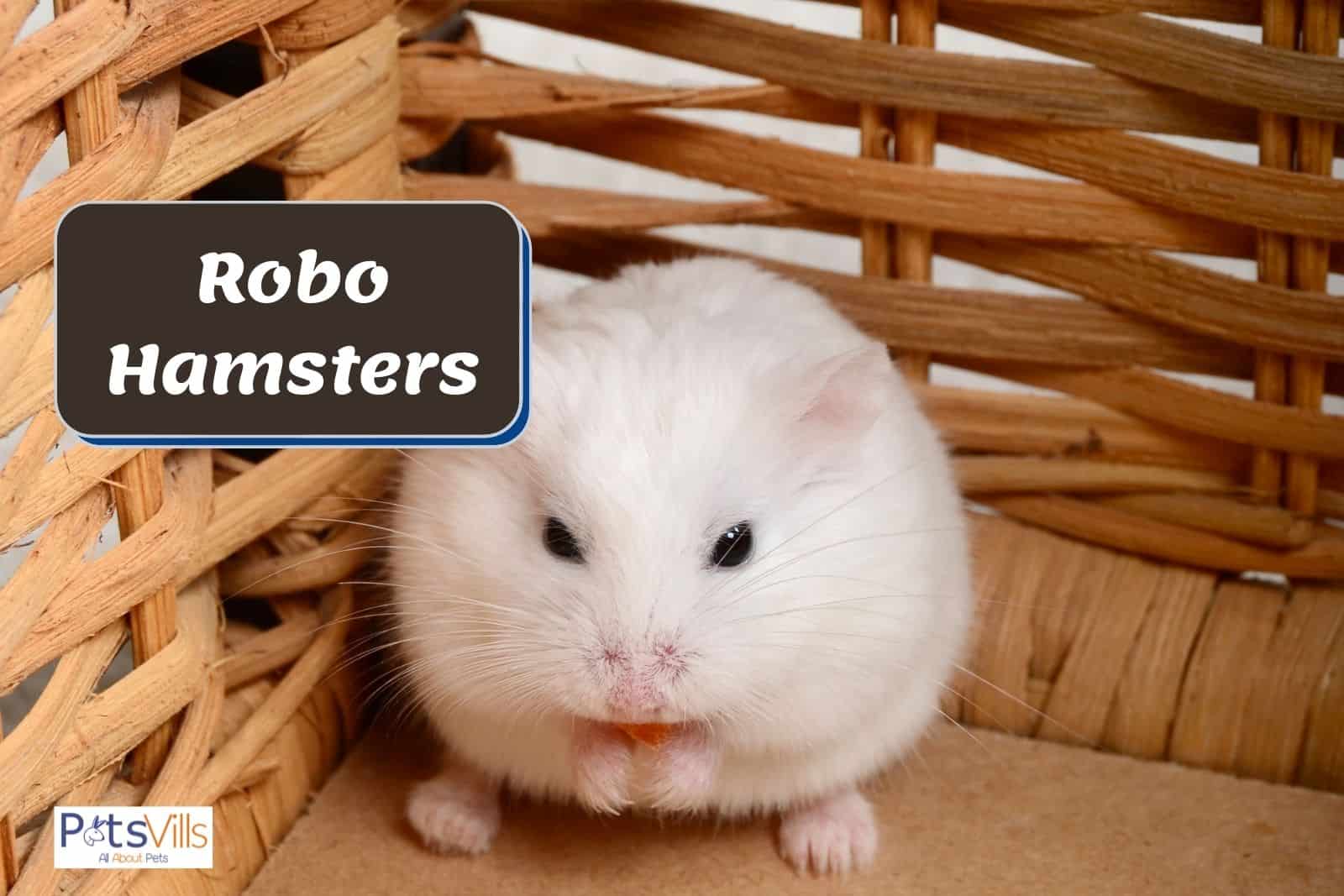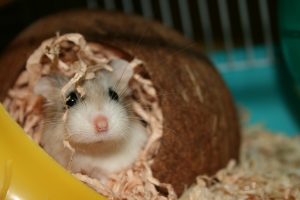
If you’ve ever wondered:
“What does a Roborovski dwarf hamster look like?”
“How do I handle and take the best possible care of my Robo hamster?”
“What type of cage should I get and should they live alone or in pairs?”
“What should I feed my Robo dwarf hamster?”
Then move no further, because in this comprehensive guide we will give you the answer to all these questions and many more.
Table of Contents
Where Does This Small Roborovski Hamster Come From?
The Roborovski Hamster is a true desert hamster.
Before becoming domesticated, the Robo hamster could only be found in the deserts of central Asia, where it inhabits areas of loose sand and sparse vegetation.
In their natural habitat, the Robo hamster runs a lot – in fact, it averages equivalent to 4 human marathons each and nightly!
Here’s a great little 2 minute, high-quality video about the Roborovski Hamster:
Check: Why Hamsters Are Goof Pets?
Robo Size And Looks (It Is The Smallest Hamster)
The Roborovski dwarf hamster is the smallest dwarf hamster around which also means it is the smallest hamster.
This means it is a very small animal and an adult Robo hamster will usually have a length of 2 inches (5cm) with a weight of around 0.5-0.75 ounces (14-20g).
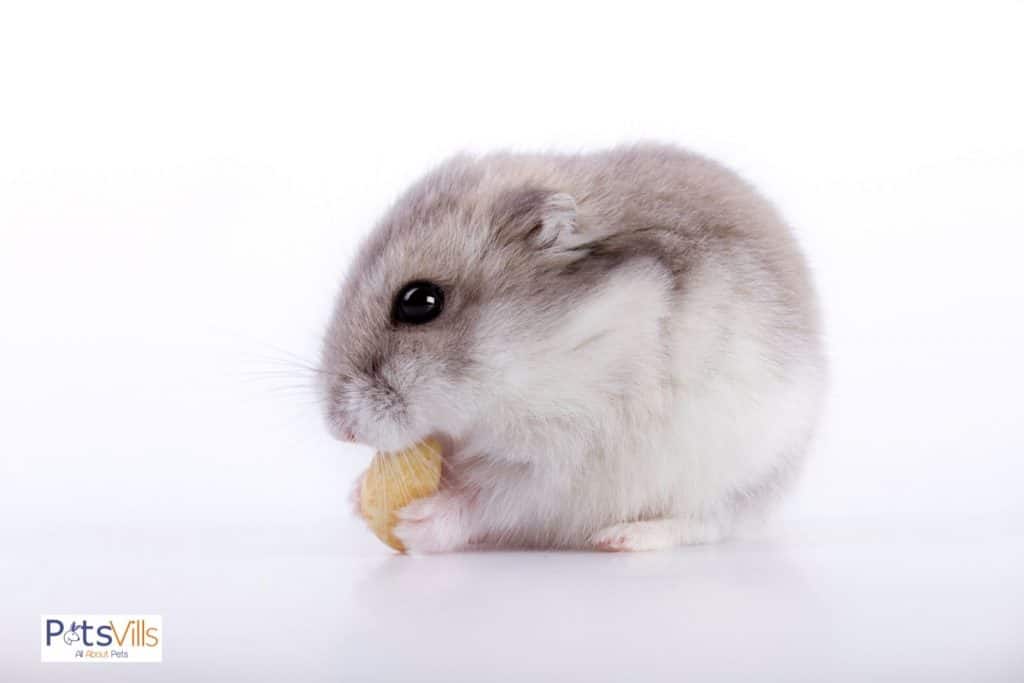
Although breeding has led to a greater variety of colors, the Robo hamster has a sandy coloration of fur and no dorsal stripe.
Some Robo’s have the same color on torso and face, but they also come in a variant white a sandy torso and white face.
This sandy color and lack of dorsal stripe, along with its smaller size, are the main distinguishing factors compared to other dwarf hamsters including Campbell’s Dwarf Hamster and the Winter White Dwarf Hamster.
To sum up, here are the main facts about the Robo dwarf hamster’s looks:
- 2 inches (5cm) long
- Weight of 0.5-0.75 ounces (14-20g)
- Sandy fur color
- No dorsal stripe
Check: Difference Between Hamster and Guinea Pig
Roborovski Dwarf Hamsters As Pets – Is It the right Hamster for Me?
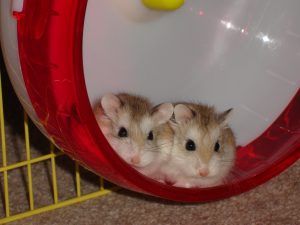
The Robo hamster is a curious and outgoing hamster making it interesting to observe.
Further, they have a friendly nature and will rarely bite humans.
However, it is also very quick and agile which combined with its small size makes it harder to handle than other hamsters, like the Syrian Hamster.
This is especially true for smaller children, who simply lack the level of control needed to handle a Robo hamster. We do not recommend children under the age of 8 handlings Robo’s.
Another factor to consider is the Robo’s are most active at dusk and dawn. Like other hamsters, the Robo is a nocturnal mammal, meaning it sleeps during the day and is active at night.
Luckily, this fits well with the typical schedule for us humans. The Robo hamster will imply sleep during the day when children are at school, allowing ample time to bond in the evening.
To sum up, here are the most important social characteristics to remember if you want to have a Roborovski Hamster as a pet:
- Interesting to observe due to its curious and outgoing nature
- Very friendly and rarely bites humans
- Hard to handle due to its small size and quick and agile moves
- Children under the age of 8 shouldn’t handle Robo hamsters
- Awake in the evening and at night, sleeps during the day
Roborovski Hamster Life Span & Other Facts
Compared to other pets, hamsters have a relatively short life span and the Roborovski is no different – it has a life expectancy of 3 years.
While this may sound like a short time (it is), it makes the species attractive for first-time pet owners who are maybe not ready for the +10 year commitment of a dog.
As such hamsters will often be the first pet in a family in which it can be “tested” whether the family is ready for the commitment that a pet is.
Of course, there are many factors influencing the life of a hamster. These include:
- Genetics
- Sickness (make sure not to keep it in a draft)
- Diet & nutrition
- How much it exercises
- Housing environment
- Level of happiness
The oldest Robo hamsters in captivity will usually not live past their fourth birthday.
READ MORE: Chinese Dwarf Hamster
Check out this video to get some perfect names for your hamster:
Roborovski Hamster Cages, Minimum Cage Size & Huts!
Unlike Syrian Hamsters, Robo dwarf hamsters can live both alone and in pairs.
Robo hamsters are perfectly fine living alone and while you need to give it a little bit more attention, this is the easiest solution.
If you want it to have a companion, you should decide on this before bringing home your first hamster. Like other hamsters, Robo’s are creatures of habit so if they are used to being housed alone, they won’t like another hamster introduced to their environment.
Here’s a quick checklist if you want to have more than in a cage:
- Introduce the two hamsters at a young age and at the latest before their 12-week birthday
- Make sure they are the same sex
- Females are easier to keep together as there is a smaller risk of fighting
- If you see any signs of a fight between your hamsters, separate them immediately
Below we have listed our three top picks for Robo hamster cages:
Table could not be displayed.
When you have found the cage you want, it’s important to have a dedicated place for your hamster to eat.
For that, you should get a food bowl with a size that’s large enough to prevent it from tipping over.
We recommend getting one made of ceramic or stainless steel as these materials cannot be chewed up and on top of that are hygienic.
Besides food, your hamster will also need water. We recommend getting a water bottle. This is again to ensure your hamster doesn’t tip it over and suddenly has to make do without any liquids.
Spills will inevitably happen, however. To minimize the effects of these spills, it’s a good idea to use a cage liner that can absorb the moisture and maintain cleanliness.
Regardless of these precautionary measures, we still recommend cleaning your cage once a week to ensure your hamster has a safe and clean environment.
Finally, you should design an area within your hamster cage where the hamster sleeps and relaxes. There are some very cute options out there for hamster huts and we especially love this option for Robo Hamsters.
Here’s a quick checklist for the Robo hamster cage:
- Get one that’s at least 24 inches long and 12 inches wide
- Increase the size by 0.5x for every extra hamster in the cage (i.e. for two hamsters the cage should be 36 inches long and 18 inches wide)
- Get a ceramic or stainless steel food bowl and a water bottle
- Designate an enclosed area for sleeping arrangements
- Clean the cage once a week
Wheels, Toys and Tubes Your Roborovski Hamster Will love
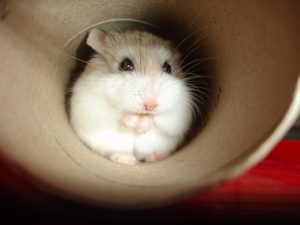
Besides playing with and entertaining your Robo, you should also make sure it can entertain itself. And that’s where toys and tubes enter the picture.
Some good cheap DIY hamster toys include cardboard boxes, toilet roll tubes, and cereal boxes.
The reason for having these toys is your Robo’s teeth are always growing and this helps keep them at a reasonable length.
Also, we recommend having some wood in the cage it can gnaw on at all times as well.
Mimic Your Robo’s Natural Instincts With The Hamster Wheel
Remember in the beginning we mentioned a Robo hamster runs equivalent to 4 humans marathons each night?
This incredible level of activity means it’s absolutely vital to have a hamster wheel where it can run its marathons.
When getting a hamster wheel there are two very important things to consider:
1: Get a plastic wheel. Metal wheels are made with rungs (like a ladder). Your hamster can fall through the traps and hurt itself.
Further, they often have sharp edges. To avoid this, get a plastic wheel made of one piece molded together.
2: Make sure it’s large enough! Your hamster should not run with an arched back. For a Robo Hamster that means the wheel should be at least 5 inches (12cm) in diameter.
Below you can see our three recommended options when it comes to Robo wheels. These are picked based on their sound level (almost silent), as wheel as having no dangers for your hamster to get caught on or otherwise injure itself:
Invalid table id.2 Amazing Robo Hamster Toys

When you have your hamster cage all set up with a hut and a wheel you should consider adding some toys.
There are essential to prevent boredom in your hamster and will help pique its curiosity, and more importantly, having something to gnaw on will help keep its ever-growing teeth in check.
You can easily find something in your home including cardboard to chew on from either cereal boxes or toilet paper rolls.
While these are often good and solid options, there is also a risk these can contain residual chemicals that are not good for your hamster.
And that’s why we recommend getting “real” hamster toys unless you are sure about your household items not containing anything that can be unhealthy for your hamster.
Stimulate Your Hamster’s Curiosity With Wooden Ladder Bridges
Our favorite Robo hamster toy is without a doubt the wooden ladder bridge. The reason we love these is you can bend them to make any shape that your hamster will love.
Further, as it’s made out of wood, your hamster can chew on it – but don’t worry, it can chew on these for many months before the wood spoils!
We recommend getting a few of these. This ensures you can always alter the look of the cage which will stimulate the curiosity of your Robo.
Your Hamster will Love Hiding In & Exploring Wooden Tunnels
Another great way to explore the cage is through using wooden tunnels. Hamsters love to hide in enclosed areas and we have had great experiences with these.
One or two of these in the cage will give your hamster a lot of ground to play on. Here’s a tunnel we’ve had great experiences with. We also absolutely adore this little tree train/tunnel.
Have Your Hamster Explore Your House From The Safety of its Hamster Ball
The final toy we recommend getting is a hamster ball. These are great for having your hamster explore your house.
As an added benefit, the hamster ball is a great place to keep your pet when cleaning out its cage. For that alone, we recommend getting a hamster ball.
When buying a hamster ball, it’s important to buy it in the right size (as with the hamster wheel). This particular hamster ball is great for Robo Hamsters as it has good size, ensuring your hamster doesn’t arch its back.
How to Handle Your Robo Dwarf Hamster
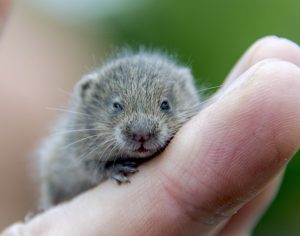
First of all: Basic hamster care is not complicated, and hamsters can become tame if you train them to be so.
There are five basic steps when it comes to taming your hamster:
- When bringing your hamster home give it 2-3 days where you don’t handle it and allow it to adjust to its new surroundings
- Start speaking with your hamster and put your hand in the cage. Do not put your hand over your hamster
- Start touching your hamster and make it comfortable with you touching it
- Start picking up your hamster, cupped in the palm of your hand
- Become best friends with your hamster and make it tame by playing with it daily (or close to it!)
For a more in-depth guide to taming your hamster, you can click here.
A final note on taming your hamster: You should never wake up your hamster when it sleeps!
Never!
This will lead to a negative response and will make the taming process significantly harder.
The other thing to note about Robo Hamsters is while they are clean animals you still need to clean the cage. You should do this once a week where you remove all the hamster bedding, clean the cage and put new bedding in.
While doing so, it can be beneficial to have a hamster ball or a playpen to keep your hamster in check.
Check this video:
Food, Diet and Treats for a Healthy and Varied Robo Hamster Diet
Robo’s run a lot so like us humans they need a good and balanced diet. Robo Hamsters are omnivorous which means they eat plants, seeds, and meat (insects).
Besides the insects, this is mimicked in the hamster food you can get.
However, there are many types of hamster food out there and it can be a challenge to figure out what is best. Generally, there are two types of food you can buy:
- Seed Hamster Food
- Pelleted Hamster Food (our preferred choice!)
Whatever type of food you decide to buy you should ensure it has the right combination of nuts, grains, and seeds with a nutritional balance of 3-6% fat and 12-15% protein. Below, we have listed our top three choices for hamster food.
Invalid table id.Seed Food: The Historical Option
Historically, seed hamster food has been the main choice of food when getting a hamster.
While it can be okay, it does risk your hamster being picky only eating its favorite seeds. This will lead to a diet not being balanced and worse, your hamster will not get all the vitamins it needs.
Thus, if you go with seed hamster food, make sure the food bowl is empty before giving it more food.
Pelleted Hamster Food: Ensures Your Hammy Gets the Vitamins It Needs
Pelleted hamster food is now considered a better option. In it, everything is mixed so every bite your hamster takes is by definition balanced. Pelleted food usually looks like small biscuits, cookies, or cereal.
Due to the balanced diet, we also recommend getting pelleted hamster food. We have had a great experience with this type of hamster food.
Your Hamster Will Indulge in These Treats
Like us, humans, “normal” food should be the main part of a hamster’s diet.
With that said, and again, just like us, humans, hamsters love treats. Luckily, most common household greens can also be used for hamster treats and hamsters especially love things including:
- Cabbage
- Spinach
- Banana
- Carrots
There are also many other snacks you can give it and we have covered hamster snacks extensively here.
We recommend giving your hamster a treat once or twice a week.
The link above is good for reference, but if you don’t have time for it now, we want you to remember one thing: Do not give your Robo hamster high acid foods including citrus and oranges.
Also, when giving treats to your Robo remember it’s a small animal so what seems like small amounts to us, can be a large amount for a Robo.
Check out this video about the things that hamsters hate.
Other Facts About the Roborovski Hamster
Roborovski Hamsters in the Wild
As we’ve already mentioned, Roborovski is native to the deserts and high steppes of Central Asia. This mostly covers the regions of Southern Eastern Russia, Kazakhstan, and North-West China.
Here it can get very hot in the Summer and very cold in the Winter.
To combat these high-temperature swings, Robo Hamster burrows deep into the ground that goes as deep as 6 feet underground (2 meters). That’s 40 times deeper than their height!
In their burrows, they not only have sleeping arrangements but also “rooms” for storing food and a blind-ending branch for urination. Often the burrows will even have multiple entrances.
Finally, these deep burrows also keep the hamster safe from other predators.
Just like when it’s housed as a pet in the comfort of your home, Robo Hamsters have been found to both live solitary lives and together with others in the wild.
As for life expectancy, it is a little shorter in the wild, and a Robo will rarely live past its second birthday. This is mostly due to the threat from other predators as well as more infrequent access to food and water.
Related: Can Hamsters Live in the Same Cage?
What to Do if Your Hamster Gets Pregnant (Babies on Board)
When you grow fond of your Robo hamster it can seem like a good idea to have hamster babies.
However, while it may seem like a good idea we recommend not attempting to have hamster babies. This is due to the American Humane Society advising against it.
The main reasons for doing so are:
- Robo hamsters may eat their babies
- It is hard to find a new home for the baby hamsters (a Robo will typically have 3-7 litters) and major pet suppliers like Petsmart and Petco do not purchase or acquire small animals from private owners
With that said, if you have Robo hamster babies or your Robo hamster is pregnant, here are the most important pointers:
- Beef up your hamster’s diet by adding calories and more protein
- Clean the cage and remove the hamster wheel and other toys, so the baby hamsters don’t injure themselves
- Leave the cage be for the last couple of days before birth. If a baby hamster gets your scent the mother may reject it
- Labor usually takes 1-2 hours with 15-30 minute intervals between the small pups coming into our world
- geuj fbbofq ofkkbf2o Do not disturb or enter the cage for at least two weeks. This again has to do with the mother potentially rejecting the babies if they get human scent.
- Make sure there is enough food and water
- Seperate the hamsters at the age of 4-5 weeks
For more information on hamster babies, we recommend reading our extensive guide here.
Robo Hamster Breeders / Adoption / Price
Robo Hamsters generally cost between $15-$35 and as such, are one of the more expensive hamsters cheap to acquire.
However, before going to a pet store we recommend looking at adopting a hamster instead. Our main reason for advising that is:
Shelters will sex the animals to make sure no one accidentally gets pregnant.
This is not necessarily the case at pet stores (it is hard to determine the sex of a hamster) and there have been stories, where people have brought home a pregnant hamster from the pet store.
For more on hamster adoption, you can check our hamster adoption guide right here.
Robo Hamsters And Hibernation
As we’ve already mentioned Robo Hamsters are from an area of the earth with extreme temperature swings.
Here it is hot in the day but due to most of the region being a desert or a high steppe, it can also get cold at night and in the Winter. If it gets cold a Robo Hamster might go into hibernation.
As a rule of thumb, a Robo can cope with temperatures between 60-78f (15-25c) easily without any adverse effects.
However, if it drops below these temperatures in the room its cage is in it may go into hibernation.
But why does my hamster need to hibernate?
Hibernation is actually a very smart ability of some animals. The reason for going into hibernation is that cold weather typically signals less food.
Instead of having the same calorie intake when there is less food, some animals simply have the ability to shut down to a minimum calorie need.
Bears are the most well-known examples, but hamsters have the same ability.
If your hamster goes into hibernation you might mistake it for being dead, as its breathing will be slow and almost motionless. Further, it will not react to sound, light, or being touched.
So how do I wake my Robo up from hibernation?
It was actually only a half-truth it won’t react to being picked up. If you pick it up and handle it gently, warming and stroking it, you will wake it up.
This tells the hamster “yay, it’s Springtime” and its organs will “wake up” again.
Robo Hamsters And Their Ever Growing Teeth
Hamsters are mammals that belong to the rodent family. In short being, a member of the rodent family means its teeth are always growing.
In other words, hamsters are born with teeth that keep growing through their entire life.
Where we humans brush our teeth, hamsters take care of their teeth (and keep their size in check) by gnawing on stuff.
If there isn’t anything to gnaw on in the cage, the hamster will simply start gnawing the cage instead – a sure sign that something’s wrong.
c vz
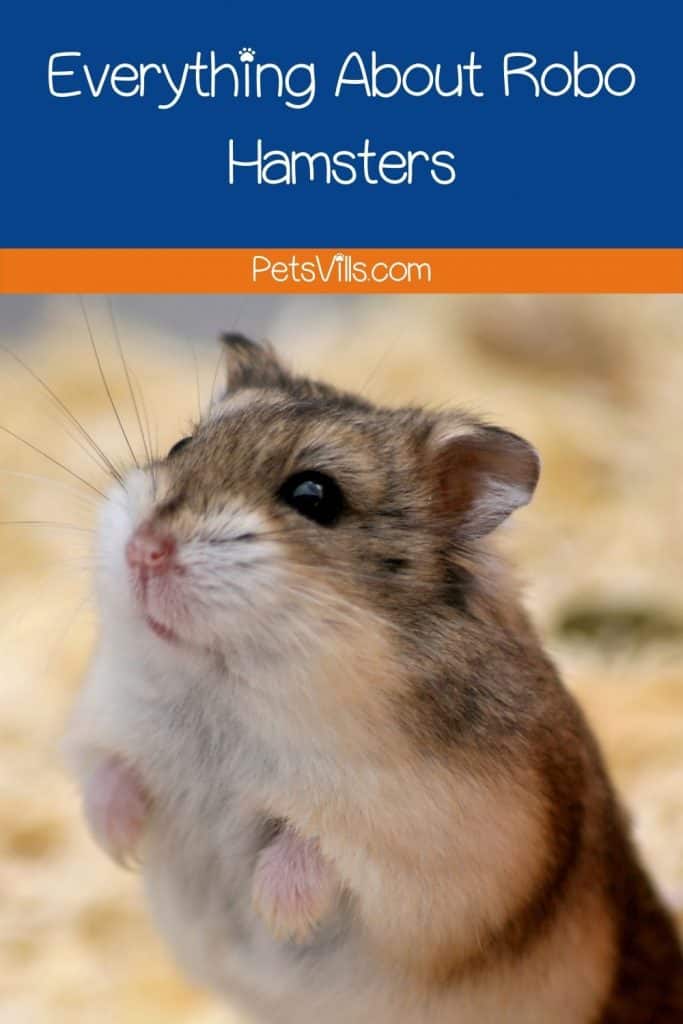
What do you love most about Robo hamsters? Please share them below!
Alina Hartley is a small-town girl with a ginormous love of bearded dragons. It all started with Winchester, a baby bearded who was abandoned at the shelter by his former owners because of a birth defect that caused one front leg to be shorter than the other. Alina originally went to the shelter looking for a guinea pig, but one look at Winchester and it was love at first sight. From that day on, Alina has dedicated her life to learning everything she can about bearded dragons. She loves helping new beardie parents start their incredible journey with these magnificent reptiles.
Follow her on:
LINKEDIN
TWITTER.
Read her latest articles HERE
Learn more about her HERE.

